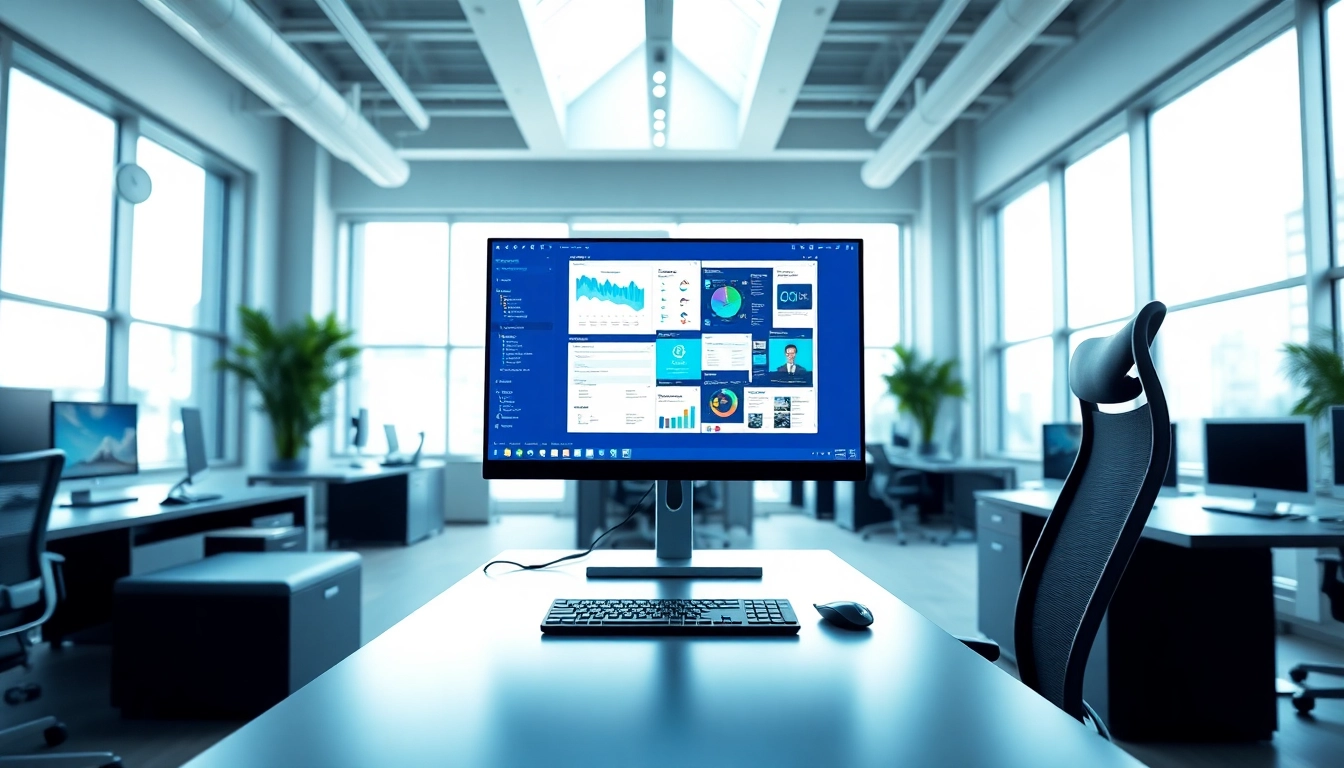Understanding Virtual Desktop Technology
What is Virtual Desktop?
A virtual desktop serves as an innovative virtualization technology that allows users to access their desktops remotely through the cloud or other networks. Essentially, it enables a user to operate their crucial applications, files, and resources from any device that has an internet connection, enhancing flexibility and productivity. By creating multiple desktop environments on a single machine or a cluster, a virtual desktop delivers a seamless user experience that mimics a traditional desktop setup while offering the advantages of virtualization.
Key Features of Virtual Desktop
Several salient features set virtual desktops apart:
- Remote Access: Users can access their desktops from any location, mitigating geographical constraints while enhancing mobility.
- Centralized Management: IT administrators can manage users and resources effortlessly from a centralized location, streamlining operations and improving security.
- Cost-Effectiveness: By utilizing existing hardware and leveraging the cloud, organizations can reduce overhead costs, including hardware updates and maintenance.
- Scalability: Virtual desktops can be easily scaled up or down based on organizational needs, accommodating fluctuating workloads without significant investments in hardware.
- Enhanced Security: Critical data is stored in secure data centers, ensuring safety from local device vulnerabilities such as theft or loss.
Benefits of Using Virtual Desktop
The adoption of virtual desktop technology presents a myriad of benefits:
- Increased Productivity: By allowing employees to work from anywhere, organizations can promote work-life balance, which can lead to increased efficiency and productivity.
- Resource Optimization: Organizations can use their existing hardware more efficiently, minimizing the need for unnecessary IT investments.
- Frequent Updates and Maintenance: With centralized desktop environments, updates and patches can be applied more uniformly and effectively, ensuring every user has access to the latest features and security protocols.
- Disaster Recovery: Data recovery solutions integrated into the virtual desktop setup can significantly reduce downtimes in case of data breaches or hardware failures.
- Customizable User Experience: Different user roles can access tailored desktop environments that cater to their specific needs, ensuring a more personalized experience.
Getting Started with Virtual Desktop
Prerequisites for Setting Up Virtual Desktop
To effectively implement a virtual desktop environment, certain prerequisites must be considered:
- Hardware Requirements: Ensure that the server hardware possesses adequate processing power, RAM, and storage capacity to handle multiple virtual desktops simultaneously.
- Network Infrastructure: A reliable and robust network is paramount. High-speed internet with low latency will ensure seamless access and interaction within the virtual environment.
- Virtualization Software: Select a suitable software solution that aligns with organizational goals; options may include popular platforms that specialize in virtual machine services.
- User Training: Employees should be familiarized with the workings of the virtual desktop interface to maximize efficiency and proficiency.
Installation Process of Virtual Desktop
The installation process of a virtual desktop system can typically be broken down into several key steps:
- Assessment: Conduct a thorough assessment of organizational requirements, including the number of users, applications, and resources needed.
- Choosing a Virtualization Platform: Select a virtualization platform that aligns with your infrastructure and support needs. Popular options include VMware, Citrix, and Microsoft Remote Desktop Services.
- Install the Software: Following the vendor’s guidelines, install the necessary software on the server.
- Configure User Profiles: Set up user profiles, assigning necessary permissions and access controls according to defined roles.
- Provision Desktop Environments: Create and provision customized desktop environments that align with user requirements.
- Testing: Conduct thorough testing of virtual desktop setups before rolling them out organization-wide.
- Training: Provide users with necessary training and support to facilitate a smooth transition.
Configuration Tips for Optimal Use
For enhancing user experience and ensuring optimal performance from the virtual desktop, consider the following configuration tips:
- Resource Allocation: Monitor server performance closely and allocate resources dynamically based on demand to prevent bottlenecks.
- Display Settings: Optimize display settings for clarity while balancing performance smoothly. Users should be encouraged to utilize settings best suited for their tasks.
- Security Settings: Establish a robust security framework, including data encryption, multi-factor authentication, and regular security audits.
- User Profiles: Create different user profiles for diverse roles to optimize resource allocation based on specific job requirements.
- Backup Protocols: Implement regular backups to prevent data loss and ensure easy recovery in the event of hardware malfunctions or cyberattacks.
Common Use Cases for Virtual Desktop
Virtual Desktop in Professional Environments
In an increasingly mobile and flexible workplace, the use of virtual desktops in professional environments translates to enhanced productivity and collaboration. Employees can access necessary resources irrespective of their location, fostering a flexible work culture that many organizations strive for today. Moreover, IT departments benefit from simplified management, allowing for quicker user onboarding and easier enforcement of security policies.
Virtual Desktop for Gaming
Gaming has found a powerful ally in virtual desktops, which allow gamers to enjoy titles on high-performance virtual machines remotely. Gamers can experience enhanced graphics and performance without being tethered to a single location by utilizing cloud gaming services. This technology enables users to enjoy PC gaming aspects anywhere by utilizing high-speed networks. Virtual desktop applications provide an immersive experience, allowing seamless transitions between gaming and other tasks.
Virtual Desktop in Education Settings
Educational institutions leverage the advantages of virtual desktops by providing students with access to necessary software applications and learning environments—regardless of their physical location. This setup facilitates distance learning while ensuring all students can access the same resources, significantly leveling the playing field. Institutions can save costs associated with software licensing and hardware while simultaneously improving student experience and performance.
Performance and Troubleshooting
Optimizing Performance on Virtual Desktop
Optimizing performance within a virtual desktop environment necessitates continuous monitoring and adjustments:
- Network Optimization: Ensure your network infrastructure meets the necessary requirements for speed and reliability to prevent lags.
- Utilizing Compression: Use techniques that compress data to speed up transfers without compromising quality.
- Monitoring Resource Usage: Have monitoring tools in place to continually assess resource consumption patterns and adjust allocations accordingly.
- Regular Updates: Keep the virtualization software and underlying operating systems updated to enhance security and performance.
- User Feedback: Encourage users to provide feedback about the virtual environment and actively make changes based on their experiences.
Troubleshooting Common Issues
Despite being highly efficient, users may experience issues that can be tackled with the following troubleshooting steps:
- Connection Issues: If users face connection-related problems, first check their internet connectivity, ensuring they are using a stable network.
- Application Crashes: Application-related crashes may result from resource limitations. Encourage users to close unnecessary applications running simultaneously.
- Performance Lag: Performance issues may stem from inadequate server capacity—monitor resources to identify potential bottlenecks and address them promptly.
- Rendering Issues: If graphical rendering problems arise, verify that the graphic settings are compatible with the user’s device capabilities.
When to Seek Professional Support
Organizations should consider seeking professional support in circumstances such as:
- Persistent Performance Issues: Continued performance anomalies that cannot be resolved through standard troubleshooting may indicate deeper complexities requiring expert intervention.
- Security Breaches: If a security breach occurs, prompt intervention from cybersecurity experts is crucial to mitigate damage and enhance safeguards.
- Major Upgrades: During upgrades or migrations of virtual desktop facilities, consulting professionals can ensure the transition occurs smoothly without data loss.
- High User Dynamics: When facing a sudden influx in users, organizations may need to engage experts for scaling guidance.
Future Trends in Virtual Desktop Technology
Emerging Trends to Watch
The future of virtual desktop technology holds exciting trends aligning with advancements in technology. Increasing integration of Artificial Intelligence (AI) and machine learning could enhance user interfaces, making systems more adaptive and responsive to individual user preferences. Furthermore, the rise of hybrid work environments will inevitably integrate virtual desktop solutions more deeply into everyday operational strategies, redefining accessibility and user environments.
Impact of Cloud Computing on Virtual Desktop
As cloud computing continues to evolve, its implications on virtual desktop solutions will become even more pronounced. The ability to scale resources in real-time will empower organizations to adjust their desktop resources dynamically based on usage patterns. This will subsequently enhance operational efficiency and reduce costs, solidifying the popularity of virtual desktop setups.
Predicted Developments in User Experience
The user experience in virtual desktops is anticipated to undergo significant enhancements through the integration of more intuitive interfaces, customization options, and improved collaboration tools. As organizations continue to prioritize employee experience, virtual desktop solutions are likely to evolve into more user-centric platforms that accommodate personal work styles and preferences.


